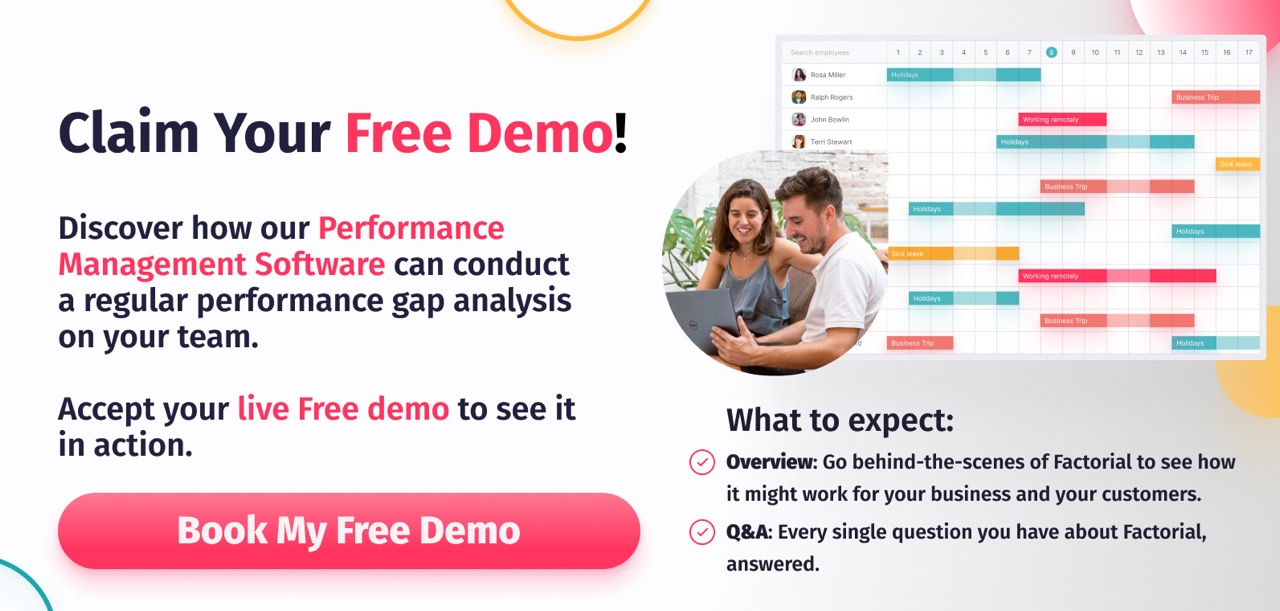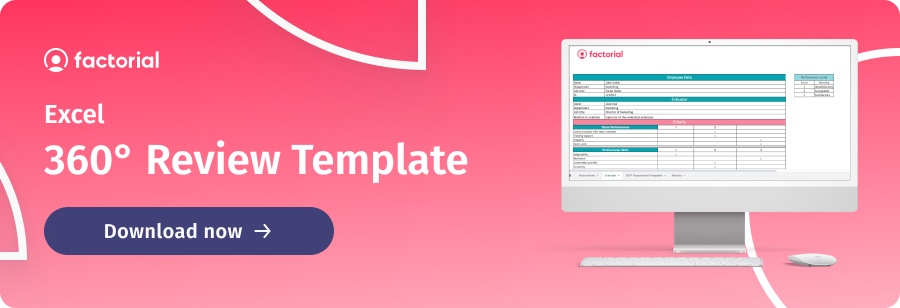The performance of your employees has a direct impact on your business. If you’re not performing well as an organization, then it is unlikely that you will hit your organizational goals. That’s why it’s so important to put measures in place to help you establish if you have a performance gap. In fact, according to McKinsey, effective performance management is essential to business. The sooner you identify and address your gaps, the better. And the best way to do this is to conduct a regular performance gap analysis.
So, what exactly is a performance gap, and what causes it? And how do you conduct a performance gap analysis?

✅ Check here our Performance Management Software
What Is a Performance Gap?
Performance gap definition: A performance gap is the difference between current and desired performance levels. The term is used to highlight discrepancies between how an individual is performing in relation to the overall performance objectives of an organization.
Performance gaps can be highly detrimental to your business. They can cause individuals, teams and organizations to underperform, resulting in a loss of revenue and profits. They can also have an effect on corporate culture, resulting in decreased motivation and satisfaction levels. This, in turn, can have a negative impact on retention levels.
The best way to establish whether there is a performance gap in your company is to carry out a performance gap analysis. With this exercise, you measure performance against established goals and benchmarks so that you can identify areas for improvement. This might be in terms of specific skills or abilities, or in relation to general performance issues resulting from a lack of motivation, clarity, or training.
Performance Gaps Examples
A performance gap can occur at any level of your company and in any department. You will usually detect them during your appraisals or when you undertake a performance gap analysis. If you do not identify and address potential issues, then they could potentially spread through your entire organization. That’s why it’s vital to always be on the lookout.
Let’s take a look at a few hypothetical performance gaps in appraisal examples to give you an idea of what you should be looking for:
- One of your sales representatives is consistently missing their sales targets. This has a knock-on effect as it prevents the sales team as a whole from missing its monthly sales objectives.
- You identify that there are continuous delays in your product manufacturing department. This is preventing products from being shipped on time, resulting in high levels of customer complaints. These complaints are overwhelming your customer service team and having a negative impact on their own performance levels.
- Your invoicing department has been underperforming recently and supplier invoices are being paid late. A number of suppliers decide to terminate their service agreement with you as a result of this. This, in turn, affects the performance of your organization as a whole as you are now unable to meet customer expectations.
5 Common Performance Gap Causes
So, what causes performance gaps?
There are a number of reasons why you might experience a performance gap in your business. Gaps can appear in any area of your business, and they may not be immediately obvious. Whatever the cause of the performance gap is, it will always have a negative impact on the organizational bottom line. That’s why it’s so important to identify performance gaps before they become ingrained in your culture.
With that in mind, let’s take a look at some of the more common performance gap causes.
- Lack of clarity. If your employees don’t have a clear understanding of what their performance goals are, then it will be difficult for them to meet them. Part of your employee performance management strategy should focus on establishing and communicating clear performance targets for each employee.
- Poor leadership. If your employees do not have clear support and guidance, then it will be a lot harder for them to perform effectively. At its worst, it can result in confusion, frustration and disengagement, further affecting individual and team performance.
- Unreasonable expectations. Are your performance goals reasonable and attainable? Do your employees have the tools and resources they need to achieve them? If not, then this will have a direct impact on performance gap management.
- General lack of motivation and disengagement. If your employees are disengaged and lack motivation, they are less likely to care about meeting performance objectives.
- Skill and talent gaps. Unless your employees have the right skills sets and abilities in order to perform their duties, it will be difficult for them to meet their performance goals.
Performance Gap Analysis: Process
Here are 6 steps that will help reduce the gaps between where your organization stands now and where you want it to be in the near future.
Identify Performance Gap Causes
The first step is to identify the causes of your performance gap. It might be one of the causes we listed above, or something else specific to your organization. If the reasons aren’t clear, then you should review your performance management records. This might help you detect any patterns or a specific point in time when performance levels dropped.
You might decide to use methods like stack ranking or tools like the 9 box grid to measure performance and map talent levels. Use Factorial’s 9 box grid template to get you started. You could even conduct surveys to get valuable input from your employees.
Conduct a Skills Gap Analysis
The next step is conducting a thorough skills gaps analysis. A skills gap analysis works in much the same way as a training needs analysis. The aim is to establish which areas of learning and development you need to focus on in order to improve the skills, knowledge, and abilities of your employees. This is an important stage as these skills gaps could be having a detrimental effect on performance levels.
Create Training Programs
Once you’ve evaluated performance levels and identified skills gaps then you are ready to create your performance improvement plan. This should include detailed training plans to help you close any identified performance and skills gaps. It’s also a good idea to implement a performance coaching plan to help support your employees.
Establish Clear Performance Goals
When you create your performance improvement plan, make sure you communicate clear performance goals so that your employees know what’s expected of them. This will give them a clear roadmap for success. Ask for their input when you create these goals as this will help you create attainable and realistic objectives.
Create the Right Culture
An important aspect of gap performance management is creating a high-performance culture that supports growth and improvement. This should form the foundation of your continuous performance management strategy. A high-performance culture is one where employees are clear on the values and goals of the company, and they have the resources, knowledge, and support needed to achieve their objectives.
Consider using incentives to motivate your employees to work on improving their performance. Examples include employee recognition programs and pay for performance initiatives.
Track Metrics & Conduct Regular Performance Appraisals
Finally, perhaps the most important step in any performance gap management strategy is tracking employee performance metrics and conducting regular employee performance reviews to keep your finger on the pulse. These should be separate from your regular salary reviews. Even if your employees work from home, you should conduct regular performance reviews for remote employees to see how employees are progressing.
A performance appraisal benefits employees and it also helps you track their progress towards meeting their goals. You can use the review to make sure they are headed in the right direction to close performance gaps and measure their progress against established KPIs and metrics.
Use Factorial’s 360 Performance Assessment template to help you track progress and identify areas for improvement. You should also encourage your employees to conduct regular self-appraisals so that they can monitor their own progress.
How to Write Performance Gaps in Appraisal
Now that we’ve answered the question “what is performance gap analysis?”, let’s take a look at what you need to keep in mind when you conduct your appraisals. These techniques will help you identify performance gaps during your employee reviews.
- State the purpose and process of your appraisal so that your employee knows why you are meeting. Explain that the main objective of the appraisal is to establish if there are any performance gaps that you can help them close.
- Acknowledge the employee’s positive contributions and accomplishments to help them feel comfortable.
- Highlight any gaps between the target goal and the employee’s current performance. Be as specific as possible and use clear metrics to back up your claims.
- Explore the impact of the employee’s performance gap on the department or business as a whole.
- Ask for the employee’s input. What do they feel is preventing them from meeting their objectives? How can you help and support them so that their performance improves?
- Agree on a plan of action to help the employee close their performance gap and make a positive impact on your organizational goals.
- Identify clear metrics that you will use to monitor the progress of the employee.
- Meet regularly with the employee to see if they need any further support. Invite them to share feedback on a regular basis.




